

7.3 Plate Tectonics and Metamorphism – Physical Geology. All of the important processes of metamorphism that we are familiar with can be directly related to geological processes caused by plate tectonics.
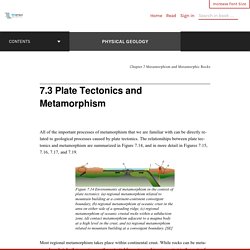
The relationships between plate tectonics and metamorphism are summarized in Figure 7.14, and in more detail in Figures 7.15, 7.16, 7.17, and 7.19. Most regional metamorphism takes place within continental crust. Pacific Northwest Seismic Network. Plate tectonics describes the motions of the 15 to 20 large rigid and brittle tectonic plates into which the Earth's outermost layer (called the "lithosphere") is broken.
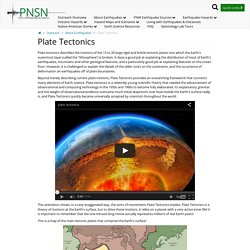
It does a good job at explaining the distribution of most of Earth's earthquakes, mountains and other geological features, and a particularly good job at explaining features on the ocean floor. However, it is challenged to explain the details of the older rocks on the continents, and the occurrence of deformation an earthquakes off of plate boundaries.
Beyond merely describing current plate motions, Plate Tectonics provides an overarching framework that connects many elements of Earth science. Plate tectonics is a relatively young scientific theory that needed the advancement of observational and computing technology in the 1950s and 1960s to become fully elaborated. High School Earth Science/Stress in the Earth's Crust. When you think about enormous plates of lithosphere traveling around on the planet's surface, you can probably imagine that the process is not smooth.
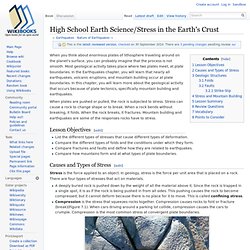
Most geological activity takes place where two plates meet, at plate boundaries. In the Earthquakes chapter, you will learn that nearly all earthquakes, volcanic eruptions, and mountain building occur at plate boundaries. In this chapter, you will learn more about the geological activity that occurs because of plate tectonics, specifically mountain building and earthquakes. When plates are pushed or pulled, the rock is subjected to stress. Stress can cause a rock to change shape or to break. New Page 3. Ophiolites. Ophiolites are pieces of oceanic plate that have been thrusted (obducted) onto the edge of continental plates.

They provide models for processes at mid-ocean ridges. Ophiolites are an assemblage of mafic and ultramafic lavas and hypabyssal rocks found in association with sedimentary rocks like greywackes and cherts. They are found in areas that have complex structure. Cross-sections simplified from R.C. Coleman, 1981, Journal of Geophysical Research, v. 86, p. 2497-2508. Ophiolites have been found in Cyprus, New Guinea, Newfoundland, California, and Oman. Ophiolites are characterized by a classic sequence of rocks. From a tectonic perspective, the peridotite is depleted mantle that was under the magma chamber at the mid-ocean ridge crest. To learn more about gabbro and other igneous rocks review the Geotour Igneous Rocks Module or visit the petrography homepage. Source of Information: McBirney, A.R., 1985, Igneous petrology: Freeman Cooper & Co.
Overview of Plate Tectonics. The Origins of Plate Tectonic Theory. The Himalayas are often referred to as the "roof of the world" because they host the highest peaks on Earth, most famously Mt.
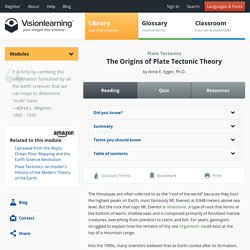
Everest at 8,848 meters above sea level. But the rock that caps Mt. Everest is limestone, a type of rock that forms at the bottom of warm, shallow seas and is composed primarily of fossilized marine creatures, everything from plankton to clams and fish. For years, geologists struggled to explain how the remains of tiny sea organisms could exist at the top of a mountain range. Into the 1900s, many scientists believed that as Earth cooled after its formation, the planet's surface contracted and wrinkled like the skin of an apple, subjected to the sun and drying out over time. To top Wegener proposes "continental drift" The story of Plate Tectonics. The British Geographer. Lecture2. The theory of plate tectonics Definition of the theory Present day plates and their velocities Evidence for the theory of plate tectonics Types of plate boundaries I.
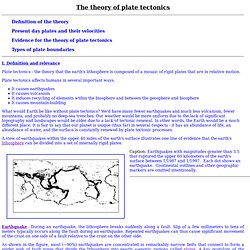
Definition and relevance. Introduction to Plate Tectonics. Dr. Pamela Gore Georgia Perimeter College. Dr. Pamela Gore Georgia Perimeter College Objectives. Proofs Of Tectonic Theory - Ocean, Magnetic, Crust, and Rocks. As with continental drift theory two of the proofs of plate tectonics are based upon the geometric fit of the displaced continents and the similarity of rock ages and Paleozoic fossils in corresponding bands or zones in adjacent or corresponding geographic areas (e.g., between West Africa and the eastern coast of South America).
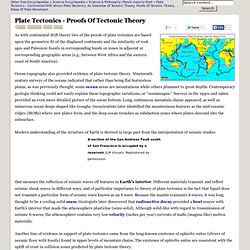
Ocean topography also provided evidence of plate tectonic theory. Nineteenth century surveys of the oceans indicated that rather than being flat featureless plains, as was previously thought, some ocean areas are mountainous while others plummet to great depths. Contemporary geologic thinking could not easily explain these topographic variations, or "oceanscapes. " Oceans & Coasts. Because oceanic lithosphere may get subducted, the age of the ocean basins is relatively young.

The oldest oceanic crust occurs farthest away from a ridge. In the Atlantic Ocean, the oldest oceanic crust occurs next to the North American and African continents and is Jurassic in age (see figure 4.6 in your text). In the Pacific Ocean, the oldest crust is also Jurassic in age, and occurs off the coast of Japan. Because the oceanic ridges are areas of young crust, there is very little sediment accumulation on the ridges. 2000 geology class. (From Geology 1404)Spring Semester, 2000PLATE TECTONICS Crust of the Earth All of the solid earth above Moho - crust Two distinct types of crust Origin of continental crust Partial remelting of original oceanic crust Crustal Structures - Faults Hanging wall - mass of rocks that lie above the shear plane Normal fault - Hanging wall goes down in relation to footwall Crust is lengthened Rift zones Reverse fault Hanging wall goes up in relation to shear plane Crust is shortened Converging (compression) zones Thrust faults Very low angle shear plane Oblique normal fault Rotation movement Lateral (strike-slip) fault Sliding blocks, sideways movement Transform plate boundary Crustal Structures - Folds Bending of earth strata Anticlines Uparching of earth strata Oldest material in the center Synclines Downward folded rocks Youngest material is in the center Monocline Single bend to the fold Domes and basins Similar to anticlines and synclines Elliptical to roughly circular in shape.
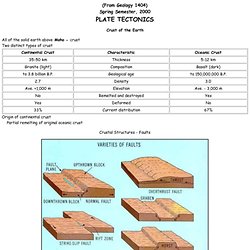
Basics of Plate Tectonics. Plate Tectonics Basics The main features of plate tectonics are: A) The Earth's surface is covered by a series of crustal plates.
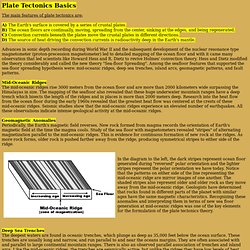
B) The ocean floors are continually, moving, spreading from the center, sinking at the edges, and being regenerated. C) Convection currents beneath the plates move the crustal plates in different directions. Global Tectonics. This either suggested that (1) the Earth has had more than one magnetic pole at various times in the past (not likely), or (2) that the different continents have moved relative to each other over time. The Encyclopedia of Earth. In the 19th and early 20th centuries, several scientists suggested that the continental masses had the ability to move across the Earth's surface. These early theories of continental drift were based on the following evidence: Locations of fossil occurrences suggested that some of the continental masses may have been connected in the geological past. Paleoclimatic evidence indicates that now tropical regions on some continents had polar climates in past Ice ages.